Study
No. of patients
Incidence
Incidence and treatment of postoperative stiffness following arthroscopic rotator cuff repair (Huberty et al. [31])
489
4.9 %
The factors affecting stiffness occurring with rotator cuff tear (Seo et al. [49])
117
32.7 %
Complications after arthroscopic rotator cuff repair (Brislin et al. [7])
263
8.75 %
Reduction of postoperative stiffness after arthroscopic rotator cuff repair: Results of a customized physical therapy regimen based on risk factors for stiffness (Koo et al. [36])
79
0 %
Stiffness and frotator cuff tears: incidence, arthroscopic indings, and treatment results (Tauro [54])
72
4.2 % resistant stiffness
Functional outcome of arthroscopic repair with concomitant manipulation in rotator cuff tears with stiff shoulder (Cho and Rhee [12])
45
3 %
Does slower rehabilitation after arthroscopic rotator cuff repair lead to long-term stiffness? (Parsons et al. [45])
43
23 %
In studies exploring etiologies of shoulder stiffness, Beaufils, Holloway, and Schenk found that patients with POSS demonstrated significantly inferior outcomes when compared to those patients with posttraumatic or idiopathic stiffness [3, 18, 29]. The prevention and management of POSS after RCR is critically important to achieving good functional outcomes where patients are capable of regaining a normal passive and active range of motion (ROM) with sufficient strength to perform activities of daily living, work, and sporting activities (Fig. 5.1) [16].
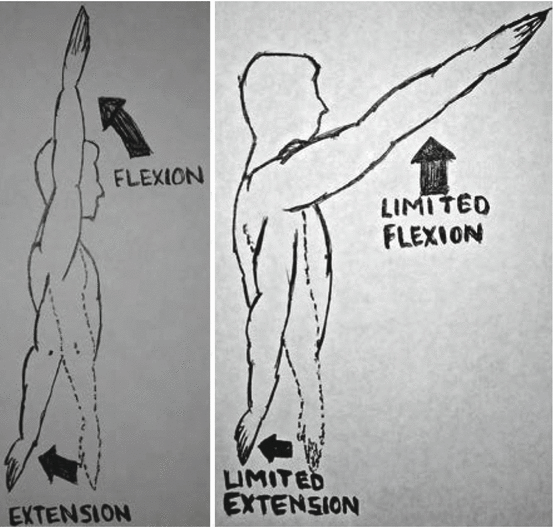

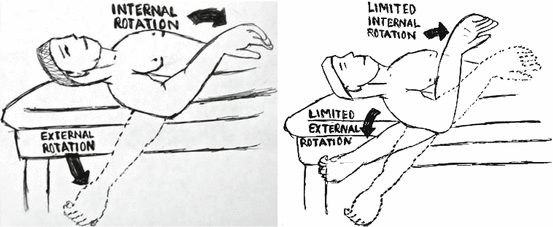



Fig. 5.1
Standardized range of motion assessment
Unfortunately, surgeon consensus is still lacking regarding the etiology of POSS and the most efficacious method(s) by which to predict and prevent its occurrence in the setting of RCR. This should come as no surprise as there is a paucity of adequately powered scientific studies to empirically define the incidence and etiology of POSS after RCR (Table 5.1). Current theories postulate that POSS may be related to postoperative immobilization, scapulohumeral adhesions, tear morphology, errors in surgical technique, capsular contracture, or underlying predisposing patient comorbidities such as diabetes to list just a few.
It is therefore extremely challenging to distill consensus from the literature regarding the true incidence and etiology of POSS after RCR. This chapter aims to objectively provide the reader with a summary of the current body of literature addressing this topic and subsequently provide a committee consensus.
5.2 Incidence
In a 2011 systematic review of the literature, Burkhart et al. aimed to define the incidence of stiffness as a primary outcome after arthroscopic rotator cuff repair (ARCR) and found only three articles providing adequate description. Papalia et al. undertook a similar literature review to Burkhart’s and identified only five publications relevant to the topic in 2012. Burkhart el. al reported an incidence of transient stiffness responsive to nonoperative management of 10 % and permanent stiffness requiring capsular release of 3.3 % [17] (Table 5.1). All three studies defined stiffness differently, thus preventing meaningful comparisons between them. In general, objectively evaluating the incidence and etiology of POSS after RCR in the literature is made difficult by studies that have been confounded by a focus on postoperative rehabilitation protocols (which have yielded conflicting results), the role for surgical interventions such as capsular release, and preoperative risk factors as it relates to tear size and morphology. Furthermore, there remain very little basic science data with only a few published studies reporting findings in an animal model [33, 46].
5.3 Definition
In an effort to further explore the relationship between rotator cuff repair and postoperative stiffness, we must first define shoulder stiffness – a task easier said than done. The definition of what constitutes a stiff shoulder is controversial in and of itself. Table 5.2 demonstrates the variability in definitions employed by current authors on this topic.
Table 5.2
Shoulder stiffness definition by authors
Study | Definition of shoulder stiffness |
|---|---|
Seo SS, et al., The factors affecting stiffness occurring with rotator cuff tear. J Shoulder Elbow Surg. 2012. [49] | Restriction of active and passive motions of 100° of elevation or less, <50 % of external rotation when compared with the motion of the contralateral shoulder and internal rotation only to the sacrum |
Parsons, B.O., et al., Does slower rehabilitation after arthroscopic rotator cuff repair lead to long-term stiffness? J Shoulder Elbow Surg. 2010. [45] | Passive forward elevation was <100° and passive external rotation was <30° in the operated-on shoulder |
Brislin KJ, Field LD, Savoie FH. 3rd, Complications after arthroscopic rotator cuff repair. Arthroscopy. 2007. [7] | Total passive external rotation with the arm at the side of <10°, total passive external rotation with the arm in 90° abduction of <30° or total passive forward flexion of <100°. Diagnosis was made only when these motion deficits persisted for 90 days postoperatively |
Tauro JC, Stiffness and rotator cuff tears: incidence, arthroscopic findings, and treatment results. Arthroscopy. 2006. [54] | Total passive ROM deficit (abduction, forward flexion, external rotation and internal rotation added together): 0–20° = mild stiffness; 25–70° = moderate stiffness and >70° = severe stiffness |
Hsu SL, et al., Surgical results in rotator cuff tears with shoulder stiffness. J Formos Med Assoc. 2007. [30] | Active and passive limitation of motion of equal to or more than half the normal range for at least 3 months. The ranges of motion were flexion 90°, abduction 90°, external rotation 25°, and internal rotation sacral level |
Postoperative stiffness is most likely the result of the surgical violation of tissue planes resulting in pathologic connections between motion interfaces, contractures of the soft tissue surrounding the articulations, and/or shortened muscle-tendon unit excursion. The sources of stiffness can occur independently of each other or in combination. From a strictly biomechanical perspective, a stiff shoulder is ultimately one in which at least one of the shoulder’s motion interfaces has been compromised, which subsequently limits maximal excursion. Several authors submit that stiffness after rotator cuff surgery is typically global but with an accentuated posterior capsular stiffness pattern. However, it is not yet clear in the literature if POSS after RCR has a predilection for motion in a singular plane or impacts global ROM. The history given by the patient is critical to identifying the etiology of stiffness. This may or may not be accompanied by clinically apparent pain and/or weakness.
We Propose the Following Definition of Shoulder Stiffness
At its core, we believe that a definition of stiffness in the postoperative setting is ultimately defined by a loss of passive motion in one or multiple planes. Thus, when joint surfaces are normal and stably aligned, and have no skeletal block, a restriction in passive ROM in any plane, as compared to the contralateral side, is classified as stiffness. This definition is conducive to defining range of motion via a standardized, quantitative, and objective measurement in degrees. These range of motion values must then be clinically contextualized by comparison to physiologic/biomechanical norms established in the literature and perhaps even more importantly, to the patient’s own physiologic control via comparison to the contralateral limb.
Postoperative changes from the violation of soft-tissue planes can cause a limitation of glenohumeral rotation in all planes, leading to a global or specific loss of active and passive motion. Comprehensive range of motion testing should include measures of forward flexion, abduction, internal and external rotation with arms at the side, and in 90° of abduction, horizontal adduction, and abduction in the scapular plane. Accurate measurements are best obtained with use of a goniometer. Physical examinations confounded by pain can benefit from targeted subacromial or intra-articular 1 % lidocaine injections to allow the clinician to discriminate between deficits in active versus passive ROM.
Finally, not all shoulder stiffness is of clinical significance and a diagnosis of shoulder stiffness must be contextualized within the clinical framework of each patient to arrive at its etiology, prognosis, and successful treatment.
It should be noted that cumulative shoulder arc of motion is also highly dependent upon a functional scapulothoracic interface. The scapula has three degrees of freedom for rotatory motion; it can move in three planes around three axes (see Fig. 5.2). Scapular movement is inherently dependent upon functional acromioclavicular and sternoclavicular joints. For every 2° of glenohumeral motion there is approximately 1° of scapular motion.
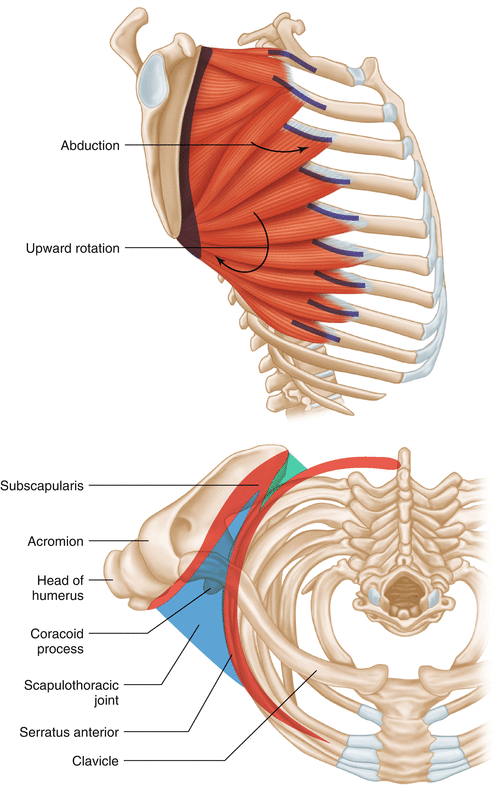

Fig. 5.2
Scapulothoracic interface
5.4 Etiology of Postoperative Shoulder Stiffness After Rotator Cuff Repair
A major challenge to the identification of the etiology(s) of POSS after RCR is the historically common practice of including all patients with reduced postoperative shoulder motion into the same study cohort. In particular, it is important not to lump all postoperative stiffness into a diagnosis category of “frozen shoulder” as this nomenclature often refers to the intra-articular pathologic condition known as primary or idiopathic stiff shoulder. Although the exact etiology of those with true idiopathic stiff shoulder is not yet clear, its resulting stiffness should likely be considered a distinct pathophysiologic process.
Unlike frozen shoulder, POSS after RCR represents an acquired loss of motion that occurs after a known surgical or traumatic event. Authors have proposed a multitude of organizational schema in an attempt to identify and classify potential factors contributing to the etiology of acquired postoperative stiffness. For example, Warner JP et al. have suggested that acquired stiffness after RCR is attributable to one or more of the following elements: (1) a preexisting comorbid condition; (2) the operative technique; or, (3) the postoperative rehabilitation protocol. Matsen et al. propose that three different basic forms of acquired shoulder stiffness can be defined: (1) intra-articular capsular contracture; (2) contractures and/or adhesions of gliding tendons such as the rotator cuff or biceps; and (3) adhesions within the extra-articular humeroscapular motion interface [25, 39]. McLaughlin believed that “acute synovitis represents one phase of the life cycle of this condition [27].” In the postoperative setting of rotator cuff repair, Harryman et al. have suggested that patients with a stiff shoulder can be categorized broadly into one of four subgroups: (1) stiffness without re-tear; (2) stiffness with re-tear; (3) stiffness with untreated osteoarthritis; and, (4) stiffness with deltoid or neurovascular injury with or without re-tear [27]. Bigliani et al. attributed stiffness to inadequate postoperative rehabilitation [6].
Although these schemas provide for a simple and structured approach to POSS, currently available literature has yet to validate this approach. Postoperative shoulder stiffness after RCR may result from a multitude of both intra-articular and extra-articular causes, including but not limited to the following (Table 5.3).
Table 5.3
Possible causes of postoperative shoulder stiffness after RCR
Extra-articular | Intra-articular |
Subacromial adhesions [17] | |
Subdeltoid adhesions | Musculotendinous unit shortening due to tendon tissue loss |
Shortening of myotendinous unit due to muscle atrophy | Secondary/acquired adhesive capsulitis [31] |
Scapulothoracic dysfunction | |
Mechanical impingement | Intrinsic osseous disease (osteoarthritis, deformity) |
Untreated A/C arthrosis | Repair failure |
Scapulothoracic dysfunction | |
Technique | Other |
Over tensioning of tendon repair | Infection |
Neurologic injury | |
Comorbidities |
5.5 Postoperative Surgical Changes: Adhesions
Postoperative adhesions represent pathologic connections between motion interfaces responsible for unencumbered shoulder motion. The actual incidence of postoperative adhesions after rotator cuff repair and their direct impact on postoperative shoulder stiffness are unknown. It has been our experience that these adhesions, particularly in the subacromial space and subdeltoid recess reside in the location of local tissue trauma secondary to portal or incision placement. Rarely are they present when a diagnosis of idiopathic frozen shoulder is responsible for shoulder stiffness.
5.6 Biomechanical Impact of Postoperative Adhesions on Shoulder Motion
Given the potential multifactorial etiology of postoperative shoulder stiffness, a basic understanding of shoulder biomechanics can aid the clinician in accurately defining stiffness and then identify the causative agent(s).
The humeroscapular motion interface is composed of a set of gliding surfaces (Fig. 5.3):
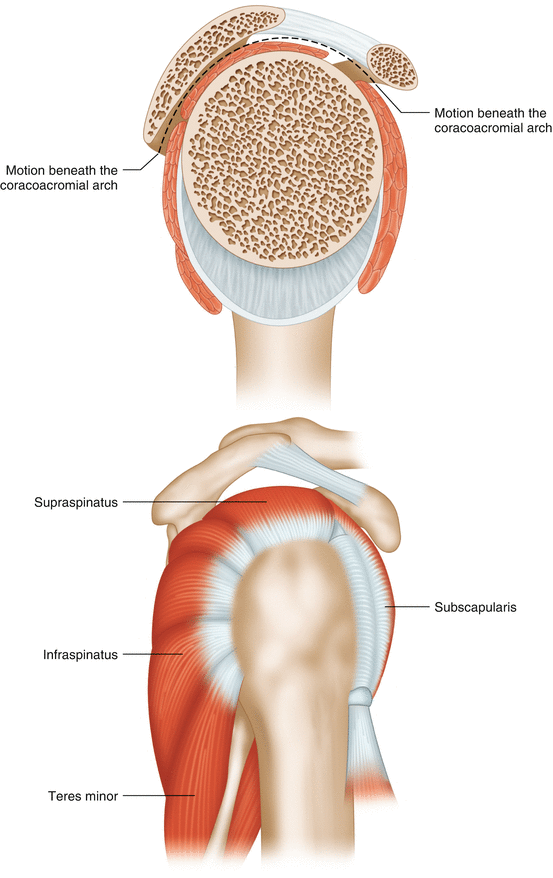

Fig. 5.3
Humeroscapular motion interfaces
Glenohumeral joint where the humeral head interfaces with the glenoid surface.
Periarticular interface(s) where the proximal humerus, covered by the rotator cuff tendons, interact with overlaying structures attached to the scapula, including the deltoid, acromion, coracoarcomial ligament, coracoid, and the tendons of the coracoid muscles.
The glenohumeral joint is inherently lax to allow for a wide range of multiplanar motion that is necessary for work, daily living, and athletic activity. A relative capsular laxity in the mid-ranges of motion is a feature of normal shoulder motion. For example, the translational laxity of the normal shoulder facilitates 1 cm of multiplanar excursion when the glenohumeral joint is in mid-range positions. Acting primarily as passive restraints, the glenohumeral ligaments work to limit excessive rotational or translational ranges. The major stabilizing force throughout the majority of mid-range positions is imparted by the dynamic compressive forces generated by glenohumeral joint musculature contractions.
Maximal physiologic multiplanar range of motion about the shoulder is dependent upon four articulations and two bursal-lined interfaces of the shoulder girdle. These interfaces must have stable alignment, smooth articular and motion plane surfaces, and must be free from contractures in the tissues about the joint. To fully mobilize the extremity, the surrounding musculotendinous units must retain both their flexibility and anatomic excursion. This has been well documented by Matsen et al. when they demonstrated that approximately 4 cm of motion takes place in the subacromial and subdeltoid space(s) during normal shoulder movement [39] (see Fig. 5.4).
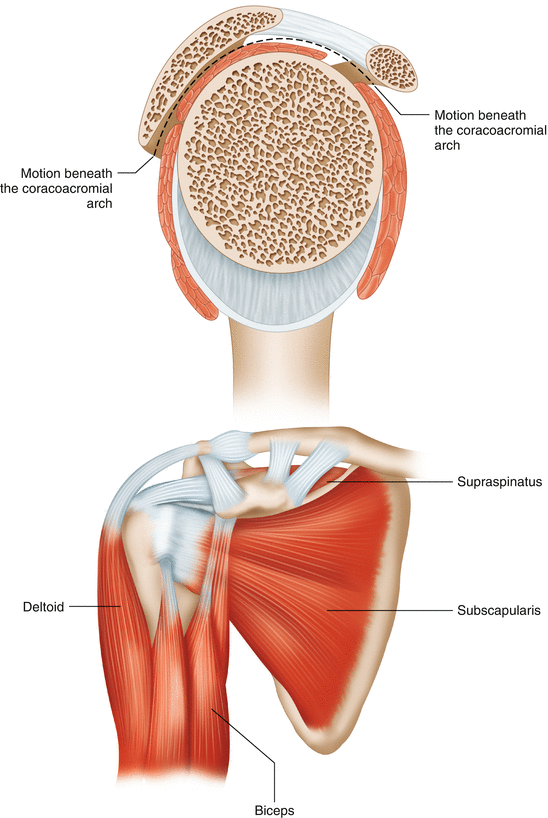

Fig. 5.4
Anatomic excursion in the subacromial and subdeltoid spaces
Scar tissue in any one or combination of the four articulations and two bursal-lined interfaces of the shoulder girdle can result in a mechanical tether. Tauro et al. reviewed a series of open rotator cuff repairs and found a 4 % incidence of significant postoperative adhesions [61]. Acting as a tether, adhesions can limit bony and soft-tissue excursion. Matsen et al. postulate that scarring and adhesions are particularly likely to occur after previous surgery or injury causing bleeding around the shoulder [40].
Matsen et al. speculated that these adhesions, or spot welds, appear to be particularly common after acromioplasty, cuff surgery, or fracture surgery, when early postoperative motion was not implemented (Great picture of Spot Welds scar tissue Matsen Shoulder Surgery, p. 45, Figs. 6–12). Although the literature remains inconclusive regarding the role postoperative motion plays in adhesion formation (see section 5.7), we do know that postoperative tissues are often inflamed and undergo hypertrophic changes. Many surgeons will attest to the thickness of postoperative adhesions in the shoulder and that attempting to lyse them with manual manipulation can require a significant force that may jeopardize the integrity of the humerus or rotator cuff.
It is difficult to quantify the incidence of POSS after RCR in our practice. However, it is a rare occurrence in our shoulder practice that a patient must return to the operating room for POSS after RCR that is refractive to extensive physical therapy. If a postoperative patient still has persistent activity-limiting stiffness 9 months postoperatively, arthroscopic lysis of adhesions with capsular release and subsequent manipulation under anesthesia is a treatment option offered to the patient. Anecdotally, a common intra-operative finding in this patient group has been extensive subacromial and subdeltoid bursal adhesions. These adhesions are particularly prevalent at the sites of previous soft-tissue trauma where tissue planes have been violated by arthroscopic cannulas or instrumentation. Often, a pervasive pattern of scar tissue formation will span the majority of the subacromial space. These adhesions are impressively thick and under dynamic arthroscopic visualization demonstrate robust tethers to cuff excursion (Fig. 5.5).
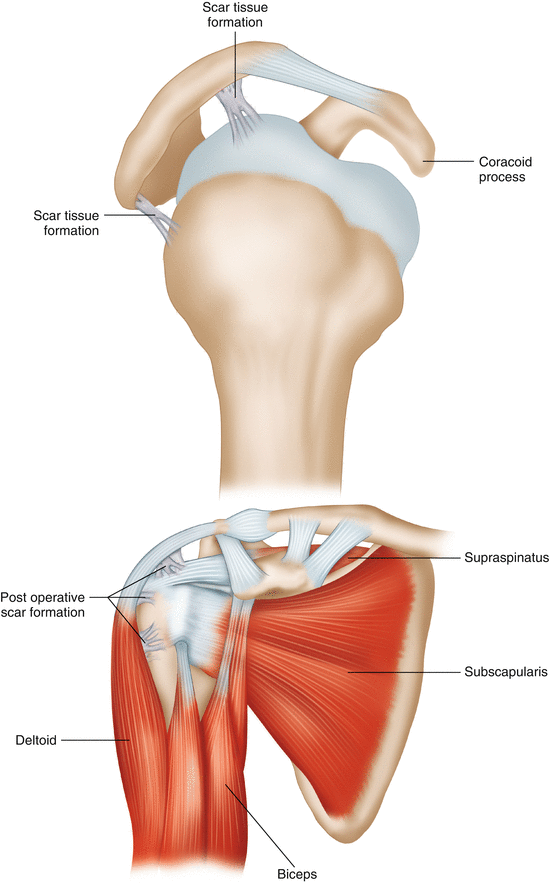
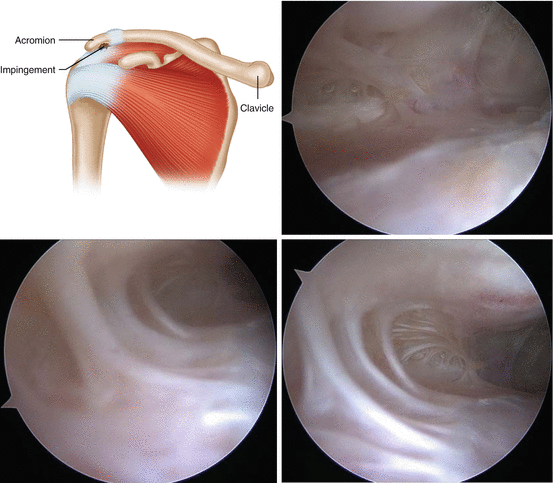


Fig. 5.5
Adhesions of the subacromial and subdeltoid spaces
In our opinion, there is a subset of patients with POSS after RCR that also present with disproportionate pain in conjunction with stiffness. We recognize that capacity for pain tolerance varies among patients. However, it has been our suspicion that patients with subjectively disproportionate pain in conjunction with POSS after RCR, may have had preoperative underlying idiopathic frozen shoulder with subsequent postoperative exacerbation (see section “Secondary adhesive capsulitis”).
5.7 Postoperative Therapy Protocols
A review of the literature demonstrates conflicting reports in regard to postoperative range of motion protocols and their impact on the incidence of postoperative stiffness. Furthermore, there are very few clinical studies on this subject. Most of the published literature evaluating the role of postoperative physical therapy after RCR has focused on therapy’s impact on rotator cuff healing rates and its influence on the rate of re-tear. These data often cite clinical experience and focused on open surgery, not arthroscopic surgery [34].
Ideally, the most efficacious postoperative rehabilitation program is one that facilitates the best clinical outcome possible where repair integrity is maintained with motion and strength optimally restored.
5.7.1 Early Postoperative Motion Protocols
Historically, postoperative stiffness was one of the most devastating complications for shoulder surgeons. “Acquired shoulder stiffness is most commonly encountered after surgery or trauma, especially after prolonged periods of immobilization” [29, 47, 60, 61]. Efforts to avoid stiffness led to the popularization of early passive range of motion after rotator cuff repair [15, 19, 28, 41]. Many surgeons are of the opinion that postoperative positioning in an abduction brace can help keep the inferior glenohumeral joint capsule stretched out, and passive stretching exercises can be initiated immediately after surgery if the repair is felt to be strong enough to withstand the stress. Proponents of early postoperative range of motion, such as Matsen et al., theorize that adhesions appear to be particularly common after acromioplasty, cuff surgery, or fracture surgery when early postoperative motion is not implemented. They theorize that stiffness may result from pathologic connections between motion interfaces, a contracture of soft tissues surrounding the articulations, or a shortening of the musculotendinous unit. A primary motivating force behind this postoperative approach was the extrapolation of flexor tendon repair data to the shoulder. Other authors, such as Abrams et al. have supported early postoperative motion protocols but have cautioned against advancing motion protocols too rapidly as this can lead to an inflammatory response [1, 62] (see Fig. 5.6). As such, Abrams et al. suggest that early postoperative motion routines may need to be modified if a patient encounters significant pain during therapy.










